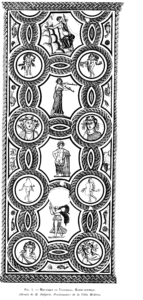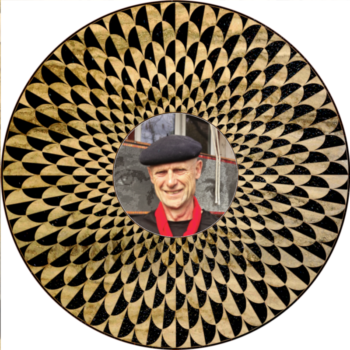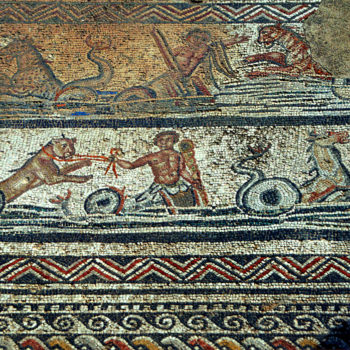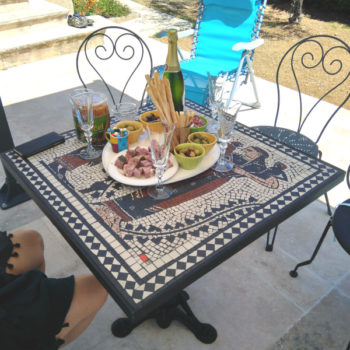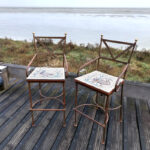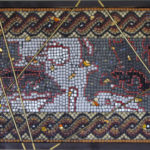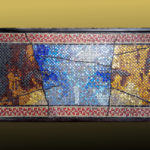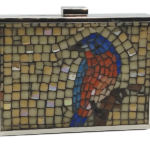An aristocratic domus
On the north side of the Decumanus Maximus of Volubilis were built the rich domus of the local aristocracy and high officials. East of the houses of Hercules and Flavius Germanus, we meet the house of Dionysos and the 4 seasons.

Its mosaic covers a rectangular room of 50 m² (500 square feet). Following a traditional pattern for a triclinium, the main mosaic, shaped like a T facing away from the entrance, is surrounded by a carpet of geometric motifs marking the place of the three beds arranged in a horseshoe.
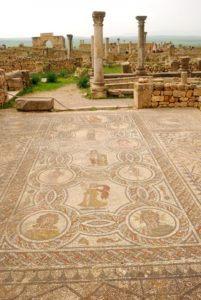
Geometric mosaic
This mosaic runs all around the room, were the beds were located. The main motif consists of hexagonal shields surrounded by a black blue cord, four to four cross-shaped.
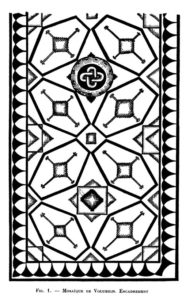
A four branched star, sometimes decorated with a knot of Solomon, occupies the space between the Crosses.
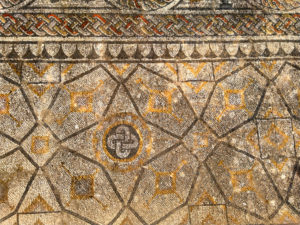
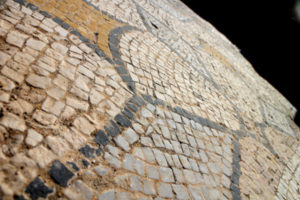
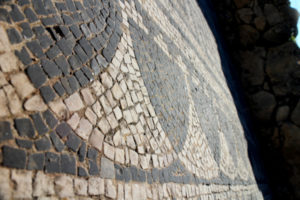
The central mosaic
The central space necessary for the service of the tables was always visible. It had received a figurative decoration.
Medusa and Nemesis
On either side of the threshold, the guests entering the room first met two apotropaic medallions of octagonal shape.
To the North – left when entering the house – Medusa’s sight would petrify indelicate guests. Six hissing snakes spring out of her dark blue hair surmounted by two spread yellow wings.
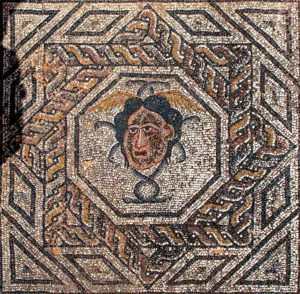
To the South – right of the Threshold – Nemesis looks even more ferocious. She is wearing a cloak on her left shoulder and an orange head-band decorated with five red gems keeps her dark blue hair flowing on her shoulders.
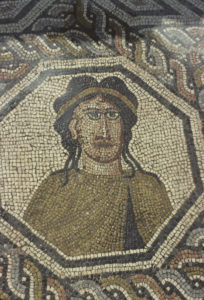
Once passed the charming welcoming Gorgons, the guests reached the beds, from where they could contemplate the central piece. From the place of honor, located to the East of the room, one could admire the intricate motifs decorating the floor.
The four seasons
This part of the mosaic faces the back of the room, away from the street, for the enjoyment of the guests.
Two vertical lines of four circular medallions representing the four seasons frame, in the center, four regular curvilinear octagons inspired by Dionysus’ lore while Fish, birds and other marine creatures evolve within 9 trapezes bordering the composition.
Inside the circular medallions, the mosaicist doubled the theme of the Seasons, alternatively using female busts and genies to incarnate them.
Such a vertical layout is quite unusual. Roman mosaicists have not often used such an architecture.
Spring
Spring is pictured at the bottom left as a girl crowned with flowers and foliage. Poppies and pomegranate flowers stud her shoulder long hair. Revealing her right arm, a pale yellow tunic is fastened on her shoulder by a large white button with a blue heart.
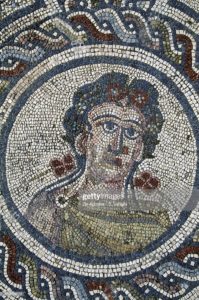
Summer
Facing her is Summer, which we recognize in the diadem of large yellow bearded wheat ears. A blue button circled with white, from which fall two small white braids, retains the black folds of her blue-green tunic.
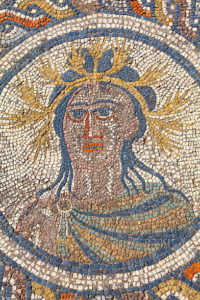
Autumn
2 medallions above Summer, we recognize Autumn girdled with grape leaves and bunches. Her right arm is left bare by a tunic she fastened on her shoulder with a blue button with a red center.
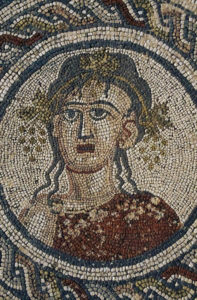
Winter
Left of Autumn, Winter protects herself from the frosts. She wrapped herself in a gray-blue coat with two red stripes in the front. A crown of reeds maintains her cap, whereas behind her shoulders pass three reeds, symbol of lean winter vegetation.
The genies
Above each season, a naked genie carries in its hand the attribute of the season: a red flower for Spring, the yellow ear of corn for Summer, vines and grapes clusters for Autumn, two dead ducks hanging from their legs for Winter back from the hunt.
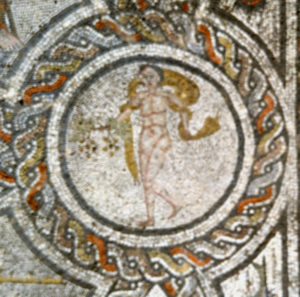
Both style of representation of the Seasons under the form of female busts or the aspect of naked genies are quite widespread in the Roman world. But the fact that they are used here both, stacked vertically in the same mosaic is unique to this particular domus.
Dionysus and his Thiasus retinue
The main character, Dionysus, leans his left arm against an altar, his right hand resting behind his hip. A blue coat covers his left shoulder, legs and thighs. The rest of his body is naked. Looking at the sky, he wears a crown of vine leaves, which allows us to recognize him.
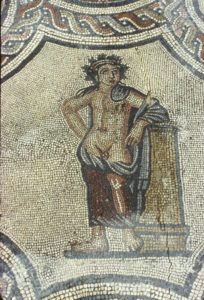
Above and below him two female musicians frame him.
The Tambourine player
Under Dionysus, a Maenad erected on tiptoe, strikes with her left hand a tambourine with little bells. Her yellow skirt lifted by her quick step, opens on her right leg and the two sides of her red scarf flow behind her. Her tunic, restrained by a high belt, follows the camber of her body carried by the dance: her head thrown back had almost completely disappeared when the mosaic was unearthed and was restored.
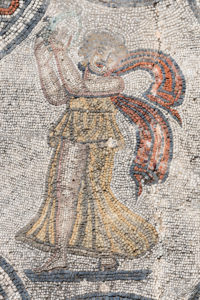
The Aulos player
Above Dyonisos, a second maenad plays the double aulos. Her long green dress fastened at the waist by a pink scarf reveals her right shoulder. Slightly bending forward, this second maenad moves slower. Her attentive gaze follows the movements of her hands applied to playing the sacred dionysiac melody.
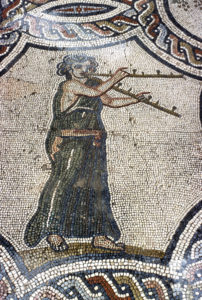
These musicians are in fact the two usual companions of Dionysus in his Bacchic thiasus, their music mark the march of the god and his followers and help provoke ecstatic intoxication.
Ariadne
Above the Aulos player, in the medallion near the threshold a woman stands her breasts and belly bared. In her left hand, she is holding another Dionysian attribute : a black spear with its blade wrapped in red. Just as for Dionysus, only her left shoulder and legs are wrapped in a pink and red coat, with its folds marked in black. She is Ariadne whom Dionysus married, after discovering her asleep on the shore of Naxos, after she had been abandoned there by Theseus (who had earlier promised to marry her when she helped him kill the Minotaur, you can’t trust those Greek heroes…)
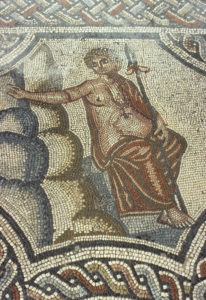
References
1951 French article about “Dionysus and the four seasons on a Volubilis mosaic” : Dionysos et les quatre saisons sur une mosaïque de Volubilis (Maroc).

